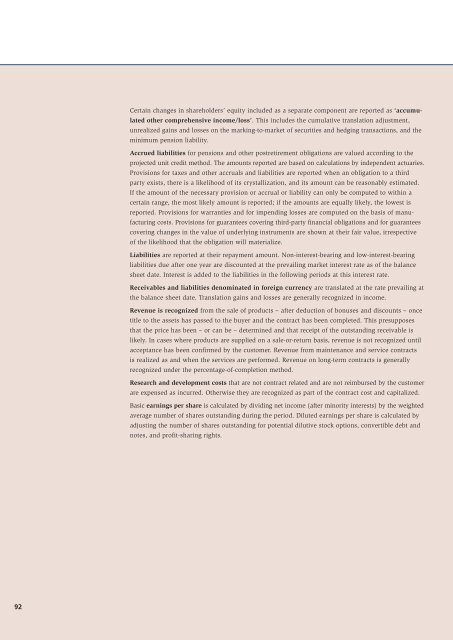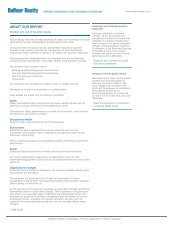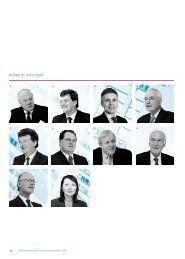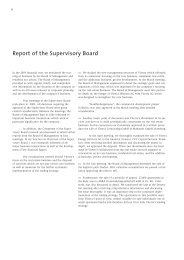E_mg_GB_03_vorne-29_3_04
E_mg_GB_03_vorne-29_3_04
E_mg_GB_03_vorne-29_3_04
Create successful ePaper yourself
Turn your PDF publications into a flip-book with our unique Google optimized e-Paper software.
92<br />
Certain changes in shareholders’ equity included as a separate component are reported as ‘accumulated<br />
other comprehensive income/loss’. This includes the cumulative translation adjustment,<br />
unrealized gains and losses on the marking-to-market of securities and hedging transactions, and the<br />
minimum pension liability.<br />
Accrued liabilities for pensions and other postretirement obligations are valued according to the<br />
projected unit credit method. The amounts reported are based on calculations by independent actuaries.<br />
Provisions for taxes and other accruals and liabilities are reported when an obligation to a third<br />
party exists, there is a likelihood of its crystallization, and its amount can be reasonably estimated.<br />
If the amount of the necessary provision or accrual or liability can only be computed to within a<br />
certain range, the most likely amount is reported; if the amounts are equally likely, the lowest is<br />
reported. Provisions for warranties and for impending losses are computed on the basis of manufacturing<br />
costs. Provisions for guarantees covering third-party financial obligations and for guarantees<br />
covering changes in the value of underlying instruments are shown at their fair value, irrespective<br />
of the likelihood that the obligation will materialize.<br />
Liabilities are reported at their repayment amount. Non-interest-bearing and low-interest-bearing<br />
liabilities due after one year are discounted at the prevailing market interest rate as of the balance<br />
sheet date. Interest is added to the liabilities in the following periods at this interest rate.<br />
Receivables and liabilities denominated in foreign currency are translated at the rate prevailing at<br />
the balance sheet date. Translation gains and losses are generally recognized in income.<br />
Revenue is recognized from the sale of products – after deduction of bonuses and discounts – once<br />
title to the assets has passed to the buyer and the contract has been completed. This presupposes<br />
that the price has been – or can be – determined and that receipt of the outstanding receivable is<br />
likely. In cases where products are supplied on a sale-or-return basis, revenue is not recognized until<br />
acceptance has been confirmed by the customer. Revenue from maintenance and service contracts<br />
is realized as and when the services are performed. Revenue on long-term contracts is generally<br />
recognized under the percentage-of-completion method.<br />
Research and development costs that are not contract related and are not reimbursed by the customer<br />
are expensed as incurred. Otherwise they are recognized as part of the contract cost and capitalized.<br />
Basic earnings per share is calculated by dividing net income (after minority interests) by the weighted<br />
average number of shares outstanding during the period. Diluted earnings per share is calculated by<br />
adjusting the number of shares outstanding for potential dilutive stock options, convertible debt and<br />
notes, and profit-sharing rights.









